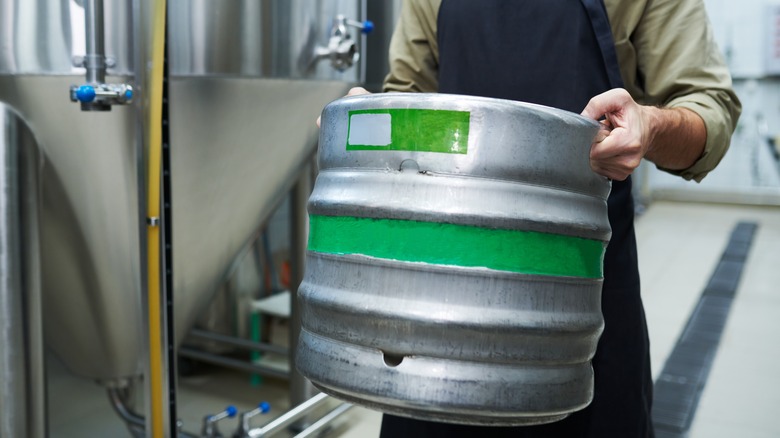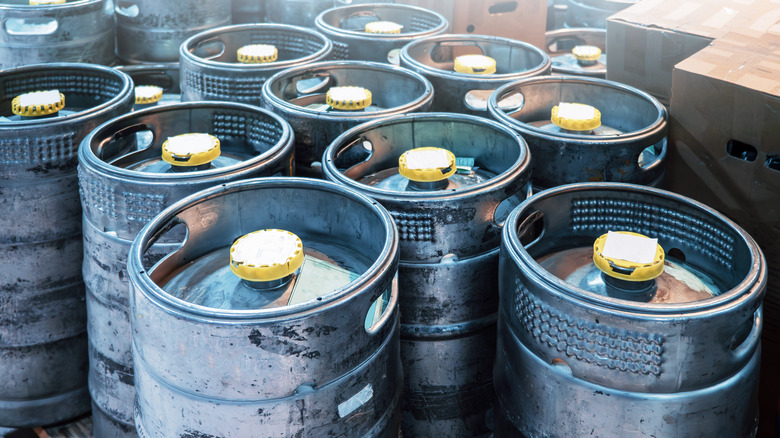How Many Beers Actually Go Into A Full-Sized Keg?
The number of beers poured from a full-sized keg boils down to three factors: the size of the keg, the size of the pour, and the alcohol by volume (ABV) of the beer. The National Institutes of Health (NIH) defines a "standard drink" as any drink containing 14 grams, or 0.6 ounces, of alcohol. The average ABV of a beer in the U.S. (like Coors Banquet, an American-style lager) is about 5%. A full-sized keg, also known as a half-barrel keg, holds 1,984 ounces of beer, or 15.5 gallons, making it the largest standard keg commercially available.
Some assumptions must be made to properly calculate how many standard pour beers actually go into a full-sized keg. For example, if a full-sized keg contained beer with 10% alcohol, it would provide twice as many standard pours as a full-sized keg containing 5% beer.
Assuming the keg holds 5% ABV beer, a standard pour would be 12 fluid ounces, roughly the size of a bottle or can of beer. Dividing 1,984 by 12 yields 165 full 12-ounce pours, with roughly four ounces remaining. So, in total, a full-sized keg provides 165 and one-third 5% ABV beers.
The number of beers you get from a keg also depends on the pour size, whether it's a flight, pint, or another unit of measurement. However, the 12-ounce pour is the standard size served by bartenders and breweries across the U.S.
Smaller kegs defined and measured
While the full-sized keg is the most commonly encountered in bars, restaurants, and breweries, kegs come in many varieties. From the mini keg to the European barrel, even the most avid beer drinkers in the world can find a keg that suits their exact needs.
The mini keg, also known as the party keg, is equivalent to a 12-pack. It contains 169 fluid ounces, or five liters, of beer, enough for 14 12-ounce pours. This keg is perfect for personal consumption or bringing to small gatherings.
The Cornelius keg, or "Corny" keg, got its start with soda manufacturers before being repurposed for beer. It contains 640 ounces, or 18 liters, of beer, which equates to 53 12-ounce pours. Cornelius kegs are particularly popular among homebrewers who prefer kegging and tapping their own beer rather than dispensing them into individual bottles.
The sixth-barrel keg is only slightly larger than the Cornelius keg. It holds 661 ounces, or 20 liters, of beer, which allows for 55 12-ounce pours. The biggest difference between the two kegs is that the sixth-barrel keg has a single line connection for both CO2 and beer, whereas a Cornelius keg has separate lines. This makes the sixth-barrel keg more efficient, but requires more expertise to use and maintain.
Larger kegs defined and measured
Quarter-barrel kegs, or "pony kegs," are the stubbier cousin of the full-sized keg. They contain 992 ounces, or 30 liters, of beer, giving 82 12-ounce pours. You'll rarely see pony kegs at restaurants, as they take up as much horizontal room as a full-sized keg, but they are the quintessential party keg seen in movies, TV shows, and the most fun family gatherings.
Slim quarter kegs, or tall quarters, contain just as much beer as a pony keg but are under 12 inches wide, as opposed to the pony keg's 16 inches. Storage space under bar counters measures horizontally more often than vertically, so these kegs are far more common in bars and restaurants that want to offer plenty of beer but aren't willing to commit to a full-sized keg.
It should come as no surprise that the 50-liter keg, or European barrel, contains 50 liters of beer. At 1,690 ounces, these kegs contain 140 12-ounce beers. You won't find many American breweries kegging their beers by this volume, but it's the most common keg used for European imports like Heineken.



